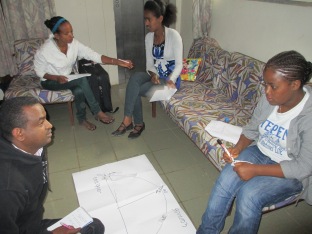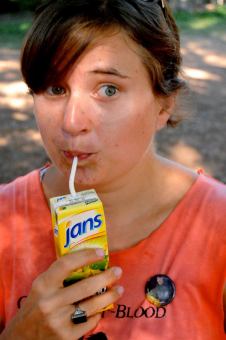27,000,000: the estimated number of human
trafficking victims in the world
1644: the
estimated number of US beds available to trafficking victims
You do the math.
Housing options for trafficking victims are severely
limited nationwide. According to a Polaris Project survey, there are a total of
529 documented beds designated for trafficking victims, and another 1115 that
are offered to trafficking victims among other vulnerable populations. A total
of eight of these beds are in Illinois.
This is no small problem.
Last week the Cook County Human Trafficking Task
Force hosted a Housing Summit in order to connect key agencies that provide
housing and shelter options for vulnerable populations like trafficking
victims. The Summit sought to identify the gaps in the existing systems and to
begin the long-term discussion on innovative ways to tackle them.
Challenges
in the current system
The needs of trafficking victims are complex and
diverse. Domestic violence shelters, homeless shelters, and other temporary
care systems have been viable resources, but they are often not equipped to
provide the protection and trauma-based care that trafficking victims need. A
lively discussion at the Housing Summit last week pinpointed the abundant
challenges.
When providing support and resources for
trafficking victims, a major obstacle is the diversity of the populations. Trafficking is a phenomenon that
transcends socio-economic, educational, gender, age, and background differences,
leading the victim services needed to be equally diverse. A safe setting for
one victim may not be a wise option for another, a prime example being a victim
needing protection from a perpetrator, necessitating security, confidentiality,
and distance. Nonetheless, this type of setting cannot be provided for every
victim, especially in open-access homeless shelters. A soft bed does not always
equate a safe place.
Another frustration with the current system is
the disorganization of resources and
collaboration. First responders are not guaranteed a secure next step in
regards to social service agencies because there is not an organized protocol
nor centralized database for the various resources available to trafficking
victims. Each agency is dependent on its own connections, none of which are
ultimately responsible for the trafficking victim’s placement.
This concern overlaps into apprehension about
some agencies’ lack of experience with
trafficking victims. Safe bed providers – shelters, private families, and
prison cells (yikes) may not have trained staff who understand the flight risk
of trafficking victims, the trauma-based care needed in all communication with
victims, and the safety needs – both physical and psychological – of the
victims. Direct service providers express concern that faith-based supporters
and other well-meaning individuals may not advocate a victim-centered approach
to care and may not have a firm grasp on how to deliver trauma-based care.
In the most practical of concerns, social
service providers also highlight difficulty with transportation of clients to the shelters. Independent agencies may
be responsible to accompany trafficking victims anywhere from two miles to 200,
depending on the location of the shelter. Public transportation may not be an
appropriate option, and there is no streamlined response to this need. While
calling 311 is an option, the service obligates a visit to a police station or
a medical center before offering transportation. Moreover, given the tension
between law enforcement and victims (many of whom have been mistreated by law
enforcement officers, may have been threatened with deportation, or may have
been denied help in the past) as well as between law enforcement and social
service providers, this is an unattractive option. Social service providers
have found the bureaucratic requirements involved in attaining permission from
the Department of Human Services to take advantage of 311 transportation
services to be more of an obstacle than helpful.
In the same vein, bureaucratic hoops regarding documentation for victims have proven
to be destructive to obtaining safe housing for trafficking victims. Many
victims lack 1) documentation at all, 2) matching documentation, or 3)
documentation of legal status. Shelters are unable to verify victims’ ages,
creating liabilities that they often cannot afford. They may not be able to service
undocumented individuals or they may have other clientele requirements that bar
particular trafficking victims from receiving care.
Some trafficked populations face more obstacles
than others. Particularly under-resourced groups are trafficked males, trafficked transgender populations, and
labor-trafficked populations (in contrast to female sex trafficking victims).
Many of the presently utilized safe beds are for victims of domestic violence,
which may be appropriate placements for female victims of sex trafficking. Few
shelters have the necessary protection for male victims, and even fewer have
appropriate options for transgender or transsexual victims. Placing a
trans-woman in a male shelter, for example, can have traumatizing effects. Cook
County lacks safe spaces and trained staff for these populations.
To that effect, a lack of “flexibility and common sense” on behalf of the shelters
has presented unnecessary challenges in obtaining safe housing for trafficking
victims. Treatment varies not only from shelter to shelter, but from staff
person to staff person, and the lack of continuity has been a primary
frustration for social services seeking provision for trafficking victims.
This list of concerns is far from exhaustive.
Looking
ahead
While the problem is daunting, the Cook County
Human Trafficking Task Force and supporters are ready to wrestle the issue. The
Housing Summit last week began the dialogue on potential responses to these
challenges through innovation and collaboration.
Participants in the Summit discussed the
physical shelter and housing options. Currently utilized are shelters for
victims of domestic violence, for youth, and for people who are homeless, though
some of the shortcomings are detailed above. Hotels also have potential for
emergency placements, especially in strategic partnership with supportive
hotels. An option for transitional housing is private family placements, which
involve extensive training and liability for the families agreeing to offer
shelter or housing to victims. For long-term placements, there are innovative models
of scatter-site housing as well as communal living. There are many
possibilities to continue exploring.
Participants also discussed the need for stages
of change and providing housing for all three levels of need: emergency,
transitional, and long-term placements. Particularly highlighted was potential
for a tiered system of services to account for each level and stage of need, as
well as for the diversity of trafficking victims’ profiles (age, gender, sexual
orientation, legal status, familial status, type of trafficking, and more).
The Summit suggested improvements to the current
system of response as well as the creation of new resources and new shelters
specifically for victims of trafficking. Potential funding opportunities were
also brought to the forefront to prioritize the coordination of trafficking
victim resources.
This is just the beginning of the discussion.
The Cook County Human Trafficking Task Force and the Summit participants will
not rest until assured that human trafficking victims have safe spaces to the
do the same.
The
Housing Summit is just one component of the Task Force’s efforts to improve
services to trafficking victims. We envision a strategic network of law
enforcement and social service providers able to meet the various needs of each
victim.
Alexa Schnieders
Program Development Intern















